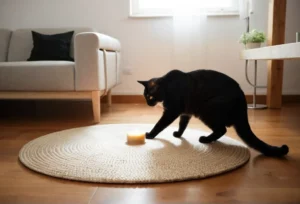Cats are known for their protective nature towards their owners and territory. But what exactly makes these furry felines so vigilant and defensive? Let’s explore the reasons behind why cats exhibit protective behavior.
Instinctual Behavior
Cats are protective creatures by nature, driven by instinctual behaviors that have been ingrained in them through generations of evolution. In the wild, cats need to protect their territory from potential threats, whether it be rival animals or predators. This protective instinct extends to their loved ones, including their human family members, as they see them as part of their pack.
When a cat feels threatened or detects danger, they may exhibit behaviors such as hissing, growling, or even puffing up to make themselves look bigger and more intimidating. These reactions stem from their primal need to defend themselves and those they care about. So, when your cat stands guard at the door or curls up next to you when you’re feeling down, it’s their way of showing you that they’ve got your back.
Bond with Their Owners
The strong bond between cats and their owners plays a significant role in their protective behavior. Cats are not as social as dogs, but they form deep attachments to their human companions. When a cat sees you as part of their family, they feel a sense of responsibility to keep you safe.
This bond is fostered through quality time spent together, whether it’s cuddling on the couch, playing with toys, or simply being in the same room. When your cat follows you around the house or sleeps on your lap, they are not just seeking companionship – they are also fulfilling their role as your protector.
In addition to their instinctual drive to protect, cats also feel a sense of loyalty and affection towards their owners. They may show their protective side by keeping a watchful eye on you, vocalizing their concern when they sense danger, or even physically intervening to prevent harm. Your cat’s protective behavior stems from their love and devotion to you, making them a loyal and reliable companion.
Threat Perception
Cats have an incredible ability to perceive threats in their environment. They are highly attuned to their surroundings, using their acute senses to pick up on even the slightest changes that could signal danger. Cats rely on their keen sense of hearing, sharp eyesight, and sensitive whiskers to detect potential threats, whether it’s a strange noise, a sudden movement, or an unfamiliar scent. This heightened awareness helps cats stay vigilant and ready to protect themselves and their territory from any perceived danger.
Vulnerability and Defense
A cat’s sense of vulnerability plays a significant role in triggering protective instincts and defensive behaviors. Despite their independent nature, cats can feel vulnerable in certain situations, especially when they feel threatened or cornered. This vulnerability can prompt them to exhibit protective behaviors, such as puffing up their fur, arching their back, and hissing or growling to ward off potential threats. Cats may also resort to defensive tactics, such as scratching or biting, to protect themselves when they feel endangered.
Key Tactics for Protection 1. Body Language: Watch out for subtle cues like flattened ears, dilated pupils, or a stiff posture, indicating that your cat feels threatened. 2. Safe Spaces: Provide your cat with hiding spots or high perches where they can retreat to feel safe and secure. 3. Socialization: Properly socialize your cat from a young age to help them feel more confident and less vulnerable in various situations. 4. Regular Vet Visits: Keep your cat healthy and up-to-date on vaccinations to reduce their susceptibility to illness and potential threats. 5. Positive Reinforcement: Encourage and reward calm behavior in your cat to build their confidence and reduce feelings of vulnerability.
Remember, understanding your cat’s instinctual behaviors and addressing their needs can help foster a strong bond built on trust and mutual respect.
Communication Through Protection
Cats often communicate their need for protection through various behaviors. When your feline friend rubs against your legs, they are marking you with their scent, a way of claiming you as part of their territory. This behavior serves as a form of protection, signaling to other animals that you are off-limits.
Additionally, when a cat curls up in your lap or lies next to you, they are seeking your companionship and protection. Cats are social animals and feel safer when they are near their human companions. By staying close to you, they are showing trust and a desire for safety and security.
Another way cats communicate their need for protection is through vocalizations. When a cat meows loudly or repeatedly, they may be signaling distress or a feeling of vulnerability. It’s essential to pay attention to these vocal cues and provide comfort and reassurance to your furry friend.
Moreover, cats may exhibit protective behavior towards their humans by standing between them and perceived threats. This act of placing themselves in harm’s way to shield their loved ones showcases their loyalty and protective instincts.
In essence, cats communicate their need for protection through various subtle behaviors, all aimed at seeking safety, security, and companionship from their trusted humans.
Maternal Instincts
A mother cat’s innate maternal instincts play a significant role in her protective nature. The bond between a mother cat and her kittens is incredibly strong, with the mother cat being fiercely protective of her young.
Mother cats create a safe nest for their kittens and will do whatever it takes to defend them from potential dangers. They exhibit vigilant behavior, constantly monitoring their surroundings and ensuring the safety of their offspring.
One fascinating aspect of a mother cat’s protective instincts is her ability to communicate with her kittens through special chirping sounds. These sounds help keep the kittens close and guide them to safety when needed. This form of communication strengthens the bond between the mother cat and her kittens and enhances their protective relationship.
Additionally, mother cats provide warmth and nourishment to their young, ensuring their health and well-being. Their nurturing nature extends beyond just physical care to emotional protection, creating a strong foundation for the kittens to grow and thrive.
Overall, a mother cat’s maternal instincts drive her protective nature, guiding her actions to safeguard and nurture her precious kittens with unwavering devotion and love.
- Mother cats may exhibit aggressive behavior towards perceived threats to their kittens, such as hissing, puffed-up fur, or even physical confrontation.
- They teach their kittens essential survival skills through play and gentle discipline, preparing them for life on their own.
- Mother cats will go to great lengths to keep their kittens safe, showcasing unparalleled dedication and sacrifice for the well-being of their young.
- Their protective instincts continue even after the kittens have grown, with many mother cats remaining watchful and supportive of their offspring throughout their lives.
Loyalty and Territory
Cats are protective creatures due to their strong sense of loyalty to their territory. They view their home as their kingdom, guarding it against potential threats like other animals or unfamiliar humans. This protective instinct stems from their natural inclination to establish and defend their territory, creating a safe space where they feel comfortable and secure. A cat will go to great lengths to protect its territory, whether it’s through vocal warnings, puffing up to appear larger, or even physical confrontation if necessary.
Social Hierarchy
A cat’s protective behavior can also be influenced by its position in the social hierarchy. In multi-cat households, dominant cats often take on a protective role towards other, more submissive cats. They may act as guards, keeping a watchful eye over the group and intervening if they sense any potential danger. This protective instinct is a way for dominant cats to maintain order and assert their authority within the social structure, ensuring that all members of the group feel safe and secure.
Additional unique insight: Cats may also exhibit protective behavior towards their human companions, viewing them as part of their social group. This protective instinct can manifest in various ways, such as seeking out their owner when sensing danger or displaying signs of distress if they perceive a threat towards their human family members. This bond between cats and their humans further highlights the deep-rooted protective instincts that cats possess.
Interesting Facts about Cat Protection
Did you know that cats are protective by nature due to their strong maternal instincts? Female cats, especially, show remarkable protective behavior towards their kittens, ensuring their safety and well-being. This instinct can also extend to their human owners, as they see them as part of their family.
Cats are territorial creatures, and this instinct often drives them to protect their home and surroundings. They mark their territory with scent glands located on their faces, paws, and tails, which serves as a protective mechanism.
In some cases, cats may exhibit protective behavior towards their owners or other pets in the household due to a strong bond formed through companionship and trust. This protective instinct can manifest in various ways, from vocal warnings to physical defense against perceived threats.
Cats have sharp senses, including exceptional hearing and night vision, making them highly alert to their surroundings. This heightened awareness contributes to their protective nature, as they are quick to detect potential dangers and respond accordingly.
Additionally, cats are known for their independent nature, but they can form strong attachments to their human companions. This bond can lead to protective behavior, as cats may feel a sense of responsibility for their owners’ well-being and safety.
Remember: Understanding the reasons behind a cat’s protective nature can help you build a stronger bond with your feline friend and create a safe and comfortable environment for them to thrive.
Additional Unique Insight
Studies have shown that cats who have been rescued or adopted from shelters may exhibit heightened protective behavior towards their owners. This increased protectiveness could stem from a sense of gratitude and loyalty towards their human companions for providing them with a loving home and care. So, if you have a rescue cat, don’t be surprised if they show extra protective tendencies towards you!
Alex, a passionate animal lover, has experience in training and understanding animal behavior. As a proud pet parent to two dogs and three cats, he founded AnimalReport.net to share insights from animal experts and expand his knowledge of the animal kingdom.




